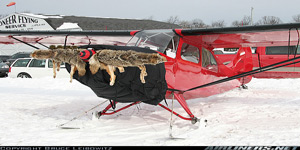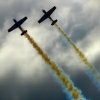Isn't it mandatory to chock your aircraft or something when doing engine tests? :-?
Whist I will not defend the guys who were in the cockpit (the buck stops etc) as a person qualified to perform full powered run ups on the said aircraft (and I do several times a month), there are a few points I would like to make.
The aircraft would have been well above idle for this to happen.
Ideally have wings full for a full power run up.
To perform a high powered run up it states in the maintenance manual that you have to have 900 meters of free and level ground in front of you. For this point I can tell you it does not happen. You do a run up were the airport tells you, like it or leave it.
When you are sat in the hot seat and monitoring the engine indications, and the aircraft moves, buy the time you notice it, you will already have travelled quite a distance. You should have a safety man in the cockpit with you, whose job it to be looking outside for this very thing.
The nose wheel steering pin should also be removed, again in case this happens, you have a fighting chance of pointing the nose in a direction of your choice.
Lastly, it is of vital importance to have the chocks placed correctly at the main wheels. That position is emphasised in the maintenance manual as being very important to minimise the chance of this sort of action taking place. The chocks should be six to eight inches
in front of the wheels and
not hard up against the wheels (as you would maybe have thought). The reason is that if the chocks are hard against the tyre, then if the brakes fail, are released, or
not applied 
then the aircraft under thrust will ride up and over them in an instant. If they are in front of the tyres, then there is a stopping effect.
Very lastly, there are absolutely no comparisons to be made between a Boeing or an Airbus in systems or operation of systems. The Boeing is manual and Le Bus, well, is not.
However, regardless of what happened, as I already said, the buck stops in the left hand seat.
Matt
"A bit of a pickle" - British translation: A catastrophically bad situation with potentially fatal consequences.
PETA

People Eating Tasty Animals.
B1 (Cat C) licenced engineer, Boeing 737NG 600/700/800/900 Airbus A318/19/20/21 and Dash8 Q-400
1. Captain, if the problem is not entered into the technical logbook.........then the aircraft does not have a problem.
2. And, if you have time to write the fault on a napkin and attach to it to the yoke.........you have time to write it in the tech log....see point 1.


 :-/
:-/

 :-/
:-/










 then the aircraft under thrust will ride up and over them in an instant. If they are in front of the tyres, then there is a stopping effect.
then the aircraft under thrust will ride up and over them in an instant. If they are in front of the tyres, then there is a stopping effect.  People Eating Tasty Animals.
People Eating Tasty Animals.
